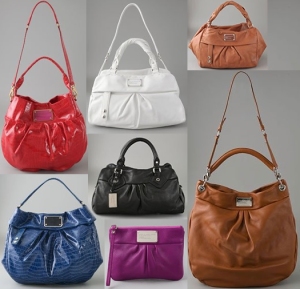After a recent conversation with my mum about how much I want one of the new season Marc Jacob’s handbag, which was so nice I died a little bit inside, she told me “You should stop wanting things” to which I replied, “Well I’ll buy it then and I won’t want it anymore”….
Perhaps this wasn’t the response she was looking for, but it did make me think, is £400 excessive for a handbag? After much deliberation between my head and my heart (or my head and my purse), I came to the conclusion that it was a bit ridiculous to spend £400 when I could buy at least 10 (or even 20) really nice bags for the same price.
I claimed I didn’t want the bag for the Marc Jacobs name. I tried to convince myself (successfully) that the bag in its own right was the reason I wanted it, for the beautiful design and the way it was finished so perfectly. But had the designer name changed my perception of the bag and made me believe it was more beautiful than it really was?
If you have studied branding and psychology at some point, I’m sure you’re aware of the Pepsi paradox, if not I’ll explain it briefly for you. Researchers found that consumers preferred Coca-Cola in a taste test where you could see brand information for both Pepsi and Coca-Cola. However, when branding was hidden and it was a simple blind taste test, more consumers preferred Pepsi, suggesting that the branding of the drinks changed the participants’ perception of the attributes of the product and actually found it more pleasing……
This is a basic low end product, but does branding have the same (or similar) effect on high end designer fashion?
Firstly, Marc Jacobs can be seen as a “Prestige Brand”, that is one which is a symbol of social status and wealth and is expensive……..normally very expensive. Consumers perception of prestige brands based upon previous experiences of the brand (both aspirational and peer reference groups), the actual attributes of the product and the hedonic values of the product (how the product makes the user feel).
Consumers may seek out the Marc Jacobs bag for a variety of reasons. A consumer with a high disposable income with a similar social circle may want the bag to conform and fit in with their friends, while a poor lowly student (like me) may want the bag to show off and to gain approval of others. The Marc Jacobs bag is probably a lot better made than a standard high street bag and so offers better quality and thus someone who is obsessed with detail may seek the bag in order to satisfy their perfectionist characteristics. As you can see from the video, the process for one of these bags is probably a lot more time consuming and completed by hand than cheap bags…There isn’t a great deal of research surrounding prestige brands, however I came across some really interesting articles surrounding the topic which are definitely worth a read.
Research has suggested that high status Prestige brands actually cause consumers to feel aroused by the product and the consumer is more likely to have a positive perception of a product than other brands. Also, it has been found that these Prestige Brands (such as Marc Jacobs) are purchased for status consumption – in order to impress others and for conspicuous consumption – in order to display wealth (and the fact you can afford to pay £400 for a handbag…….which is actually one of the cheapest bags in the range).
So…..I probably wanted the bag to show off to my friends that I had been working so much over summer I could afford it and because it elicited arousal and made me believe that it was more pretty in my mind than in reality (although I strongly disagree with that last one since it definitely was amazing in reality).


